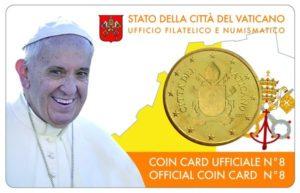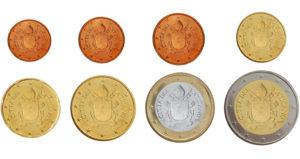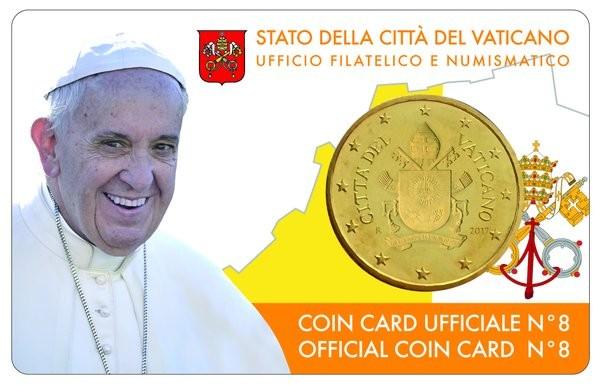Since Pope Francis views himself as “the pope of the poor,” it appears to be ironic that Vatican City coins on which his image appears are selling for far more than is their face value.
The fact that Vatican City’s euro coins are severely limited in mintage and for that reason command a high premium among collectors has not been lost on the pope. The pope has no control over how many Vatican City coins are struck annually, but he does have control over what appears on the so-called “national” side of the coins. On Jan. 27 the Italian wire news service Agenzia Nazionale Stampa Associata announced that the pope’s image is being replaced with his heraldry on the upcoming 2017 issue expected to be released in March. Standard symbols of the European Union will continue to appear on the EU side of these coins, as do these images on all standard EU currency union coins issued by other participating countries.
 Vatican coinage is produced at the Istituto Poligrafico e Zecca dello Stato, or Italian State Mint, and sold through the Vatican Philatelic and Numismatic Office. The mint is authorized to strike a maximum of 1 million euro in value for the Vatican annually. In 2016, the mint struck 70,000 BU and 10,000 proof sets for the Vatican, each with a face value of 3.88 euro based on a total of eight coins ranging from 1 euro cent to 2 euro. The total face value of these coins is 310,400 euro. The BU set was initially released for 35 euro (about $37.40 US).
Vatican coinage is produced at the Istituto Poligrafico e Zecca dello Stato, or Italian State Mint, and sold through the Vatican Philatelic and Numismatic Office. The mint is authorized to strike a maximum of 1 million euro in value for the Vatican annually. In 2016, the mint struck 70,000 BU and 10,000 proof sets for the Vatican, each with a face value of 3.88 euro based on a total of eight coins ranging from 1 euro cent to 2 euro. The total face value of these coins is 310,400 euro. The BU set was initially released for 35 euro (about $37.40 US).
Vatican euro coins are authorized through a monetary convention with Italy that was acted on behalf of the European Community on Dec. 29, 2000. Vatican euro coins are legal tender throughout the currency union participant members of the EU. Due to the popularity and scarcity of the coins, they sell for significantly higher values. An uncirculated Vatican City 2016 Holy Year of Mercy 2-euro was recently offered on eBay for a “Buy It Now” price of $34.90, while the 2014 BU set of eight coins was being offered for 220 euro. The U.S. equivalent face value of these two are approximately $2.14 and $4.15, respectively.
The change in the image appearing on the national side of the coins was requested during 2016 by the pope. His heraldry is comprised of a bright blue background with yellow radiant sun accompanied by the “IHS” christogram at center top. A cross pierces the “H” in red with three black nails directly under them. To the lower left is a star representing Mary, Mother of Christ, and the church. To the right of this star is a nard flower representing Joseph as patron of the universal church. Francis’ heraldry has no supporters but displays the legend “miserando atque eligendo” (By having mercy, by choosing him).
Vatican euro-denominated coins first appeared in 2002. These coins depict the image of Pope John Paul II on the national side. John Paul’s successor, Pope Benedict XVI, appears on coins issued during the time of his papacy. Pope Francis appears on coins beginning in 2014 through 2016.

Papal coins have been issued although often sporadically since the time of Pope Zacharias (741-752). No papal coins have been identified as being issued between 984 and 1304, likely because the Senate of Rome attempted to replace papal temporal power during that time. The local mint was taken over by Rome in 1143. In 1188, an agreement was made with Pope Clement III through which half the mint profits were assigned to the mayor. Various mints operated, striking papal coins during the time when the pope governed papal states. Modern united Italy took over the papal mint in September 1870, striking coins for Italy rather than for the Vatican. It wasn’t until 1931 when coins were struck there for the now-independent city-state of Vatican City. Some of these coins were backdated to 1929.
All popes since Pope Pius XI have issued coins, although the only issue of the short-reigning Pope John Paul I was a silver 1,000-lire commemorative struck posthumously.

